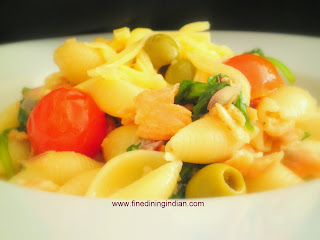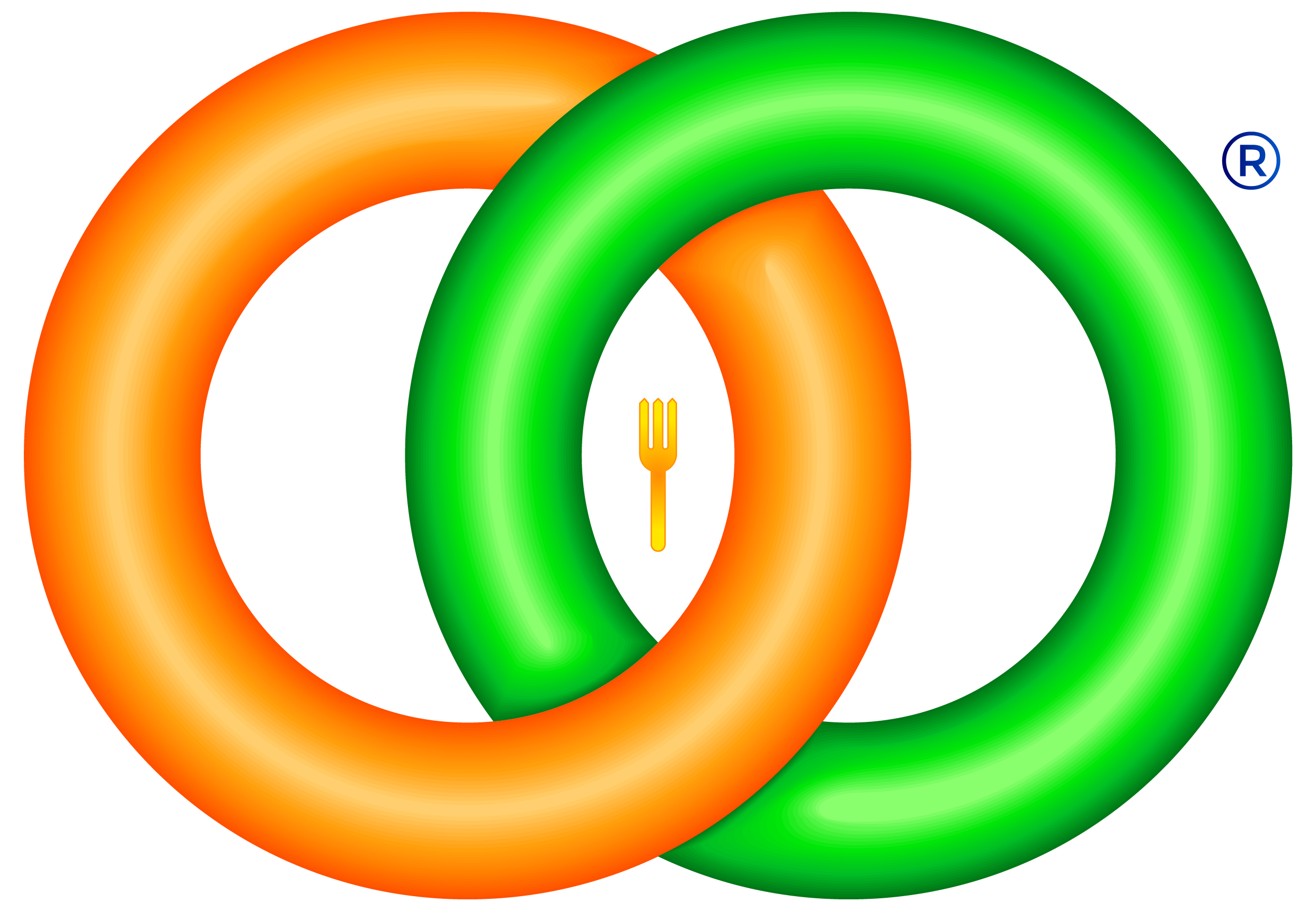
A Summer Special Conchiglie Pasta With Smoke Salmon, tomato Cherries
A very easy summer pasta preparation, quick to make when you are at home or even when you have a guest want a refreshing pasta dish.
History of Pasta
 Pasta is believed to have originated in China: the oldest known pasta or noodle-like food were found in China at the Qijia culture Lajia site in Qinghai province. The 4,000-year-old noodles appear to have been made from foxtail millet and broomcorn millet. According to historians like Charles Perry, the arabs adapted noodles for long journeys in the 5th century, the first written record of dry pasta. Arabs introduced this version of pasta to Sicily, during the invasions in the 8th century.
Pasta is believed to have originated in China: the oldest known pasta or noodle-like food were found in China at the Qijia culture Lajia site in Qinghai province. The 4,000-year-old noodles appear to have been made from foxtail millet and broomcorn millet. According to historians like Charles Perry, the arabs adapted noodles for long journeys in the 5th century, the first written record of dry pasta. Arabs introduced this version of pasta to Sicily, during the invasions in the 8th century.
Ingredients
- conchiglie pasta – 250 gm
- smoke salmon – 100 gm
- olive – 20 gm
- baby spinach – 200 gm
- Cherry tomato – 50 gm
- chopped onion – 50 gm
- chopped garlic – 10 gm
- extra virgin olive oil – 10 ml
- Parmesan shaving – 25 gm
- white wine – 100 ml
- salt – to taste
- pepper – to taste
Method
- Heat olive oil in a thick bottom pan add garlic stir till golden color,add onion sweat for a while
- Pour in white wine let it reduce 1/3rd add smoke salmon,cherry tomato,salt ,pepper
- Toss in boiled pasta , mix baby spinach , olives
- Serve hot drizzle with extra virgin loive oil,grated parmesan
History of Pasta
 While many different cultures ate some sort of noodle-like food, composed mostly of grain, the key characteristic of Italian dry pasta is durum wheat semolina, with a high gluten content. Furthermore, it is made with a technique that allows the resultant dough to be highly malleable, thus resulting in the many different shapes (i.e., ziti, spaghetti, ravioli) that characterize “pasta.” But durum wheat semolina is not used to make fresh
While many different cultures ate some sort of noodle-like food, composed mostly of grain, the key characteristic of Italian dry pasta is durum wheat semolina, with a high gluten content. Furthermore, it is made with a technique that allows the resultant dough to be highly malleable, thus resulting in the many different shapes (i.e., ziti, spaghetti, ravioli) that characterize “pasta.” But durum wheat semolina is not used to make fresh
homemade pasta. In North Africa, a food similar to pasta, known as couscous, has been eaten for centuries. However, it lacks the distinguishing malleable nature of what is now referred to as pasta, couscous being more akin to droplets of dough. In China, noodles of wheat, millet or rice have been eaten for many thousand years. At first, dry pasta was a luxury item in Italy because of high labor costs, durum wheat semolina had to be kneaded for a long time. Only after the industrial revolution in Naples, when a mechanical die process allowed for large scale production of dry pasta, that’s when it became affordable and popular among the common people.
Historians have noted several lexical milestones relevant to pasta, none which change these basic characteristics. For example, the works of the 2nd century AD Greek physician Galen mention itrion, homogeneous compounds made up of flour and water. The Jerusalem Talmud records that itrium, a kind of boiled dough,was common in Israel from the 3rd to 5th centuries AD,A dictionary compiled by the 9th century Arab physician and lexicographer Isho bar Ali defines itriyya, the Arabic cognate, as string-like shapes made of semolina and dried before cooking. The geographical text of Muhammad al-Idrisi, compiled for the Norman King of Sicily Roger II in 1154 mentions itriyya manufactured and exported from Norman Sicily:
 West of Termini there is a delightful settlement called Trabia. Its ever-flowing streams propel a number of mills. Here there are huge buildings in the countryside where they make vast quantities of itriyya which is exported everywhere: to Calabria, to Muslim and Christian countries. Very many shiploads are sent.
West of Termini there is a delightful settlement called Trabia. Its ever-flowing streams propel a number of mills. Here there are huge buildings in the countryside where they make vast quantities of itriyya which is exported everywhere: to Calabria, to Muslim and Christian countries. Very many shiploads are sent.
Itriyya gives rise to trie in Italian, signifying long strips such as tagliatelle and trenette. One form of itriyya with a long history is laganum (plural lagana), which in Latin refers to a thin sheet of dough,and gives rise to Italian lasagna.
The Chinese were eating noodles made of millet as long ago as 2000 BC. This has been suggested by the discovery of a well-preserved bowl of millet noodles over 4000 years old. However, durum wheat was not known in China until later times. There is a legend of Marco Polo importing pasta from China which originated with the Macaroni Journal, published by an association of food industries with the goal of promoting the use of pasta in the United States. Marco Polo describes a food similar to “lagana” in his Travels, but he uses a term with which he was already familiar. Durum wheat, and thus pasta as it is known today, was introduced by Arabs, specifically in Libya, during their conquest of Sicily in the late 7th century, according to the newsletter of the National Macaroni Manufacturers Association, thus predating Marco Polo’s travels to China by about six centuries. We know from written records that pasta was in Italy before Marco Polo’s return, but the concept of stuffed pasta didn’t exist yet. Some historians believe that in 1295 Marco Polo brought rice flour pasta, the type used to make Chinese dumplings. Now known as dumpling style or soft pasta, which manifested into ravioli, gnocchi and other similar preparations.In the 1st century BC writings of Horace, lagana were fine sheets of dough which were fried and were an everyday food.Writing in the 2nd century Athenaeus of Naucratis provides a recipe for lagana which he attributes to the 1st century Chrysippus of Tyana: sheets of dough made of wheat flour and the juice of crushed lettuce, then flavored with spices and deep-fried in oil. An early 5th century cookbook describes a dish called lagana that consisted of layers of dough with meat stuffing, a possible ancestor of modern-day Lasagna. But the method of cooking these sheets of dough does not correspond to our modern definition of either a fresh or dry pasta product. The first concrete information concerning pasta products in Italy dates from the 13th or 14th century. The name (λαγάνα, lagána) survives in modern-day Greece to denote an unleavened, flat bread eaten during the Great Lent.The term “lagana” is also used in the Southern region of Calabria, where it indicates a flat noodle. (wikepedia)
2 Comments
-
Samual
Wow, so delicious way. Knowing what you have put in your food dictates the kind of nutrition and value you give for yourself.
Comments are closed.

During Newquay holidays you can sample a wide variety of cuisine that is served by excellent restaurants and prepared by world class chefs. Indian food is very popular all over the world and even more famous all around the British aisle. Cornwall holiday cottages are equipped with cooking facilities that are perfect for families and groups but a trip to one of the exotic Indian restaurants in town is surely an experience that cannot be missed. Indian food is very flavourful because of the numerous spices that are infused in all of their dishes.